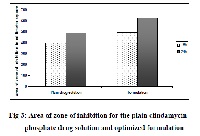Ion activated bioadhesive in situ gel of clindamycin for vaginal application
Keywords:
sol-to-gel system, chitosan, gellan gum, vaginal, clindamycinAbstract
Vaginal preparations, although generally perceived as safer most , still they are associated with a number of problems, including multiple days of dosing, dripping, leakage and messiness, causing discomfort to users and expulsion due to the self-cleansing action of the vaginal tract. These limitations lead to poor patient compliance and failure of the desired therapeutic effects. For effective vaginal delivery of antimicrobial agents, the drug delivery system should reside at the site of infection for a prolonged period of time. In our present work, we have developed and optimized a chitosan (bioadhesive and permeation enhancer) and gellan gum (ion activated gelling polymer) based in situ gel system of clindamycin for vaginal application. The developed formulation was characterized for various in-vitro parameters e.g. clarity, refractive index, pH, isotonicity, sterility, viscosity, drug release profile, statistical release kinetics, bioadhesive force, retention time, microbial efficacy, irritation test and stability studies. To simulate vaginal conditions, a synthetic membrane (cellophane hydrated with modified simulated vaginal fluid) and sheep vaginal mucosa were used as model membranes. The developed formulation was found to be non irritant, bioadhesive with good retention properties. Developed formulation shows matrix model release kinetic by PCP disso software. The developed formulation is thus a viable alternative to conventional vaginal dosage forms.
References
Okada, H. Vaginal Route of Peptide and Protein Delivery. In Peptide and Protein Drug Delivery; Lee, V.H.L., Ed.; Marcel Dekker: New York, 1991; 633–666.
Harrison, P.F. Microbicides: Forging Scientific and Political Alliances. AIDS Patient Care and STDs 2000, 14 (4), 199–205
Merabet J, Thompson D, Saul LR, Advancing vaginal drug delivery. Expert opinion drug delivery, 2005;2(4):769-77.
Chopra S., Motwani SK, Iqbal Z, Talegaonkar S, Ahmad FJ, Khar RK, Optimisation of polyherbal gels for vaginal drug delivery by Box-Behnken statistical design, European Journal of Pharmaceutics and Biopharmaceutics, 2007 (67); 120–131.
Jain SK, Jain NK, Gupta Y, Jain A, Jain D, Chaurasia M. Mucoadhesive chitosan microspheres for non-invasive and improved nasal delivery of insulin. 2007, 64(4); 498-504.
Owen DH, Katz DF, A vaginal fluid simulant, Contraception, 1999 (59); 91–95.
Mortazavi SA, Carpenter BG, Smart JD, An investigation of the rheological behaviour of the mucoadhesive/mucosal interface. Int. J. Pharm., 1992 (83); 221–225.
Tamburic S, Craig DQM, An investigation into the rheological, dielectric and mucoadhesive properties of poly(acrylic acid) gel systems, J. Control. Release 37 (1995) 59–68.
Gilbert JC, Richardson JC, Davies MC, Palin KJ, Hadgraft J, The effect of solutes and polymers on the gelation properties of pluronic F-127 solutions for controlled drug delivery, J. Control. Release, 1987 (5);113–118.
Orwa JA, Vandenbempt K, Depuydt S, Roets E, Hoogmartens J, Liquid chromatography method for separation of clindamycin from related substances. Journal of Pharmaceutical and Biomedical Analysis, 1999, 20 (5); 745-752.
Gupta A, Garg S, Khar RK, Measurement of Bioadhesive Strength of Mucoadhesive Buccal Tablets: Design of an In Vitro Assembly. Indian Drugs, 1993, 30 (4), 152–155.
Vermani K, Garg S, Zaneveld LJD, Assemblies for In Vitro Measurement of Bioadhesive Strength and Retention Characteristics in Simulated Vaginal Environment, Drug development and industrial pharmacy, 2002, 28(9), pp. 1133–1146.
Sultana Y, Aqil M, Ali A, Ion-Activated, Gelrite_R-Based in Situ Ophthalmic Gels of Pefloxacin Mesylate: Comparison with Conventional Eye Drops, Drug Delivery, 2006, (13); 215–219.
Velpandian T, Bankoti R, Humayun S, Ravi AK, Kumari SS, Biswas NR, Comparative evaluation of possible ocular photochemical toxicity of fluoroquinolones meant for ocular use in experimental models, Ind. J. Exp. Biol., 2006 (5); 387.
Spielmann H, Ocular irritation. In Vitro Methods in Pharmaceutical Research, ed. Castle, J. V., and Gomez, M. J. (Eds.), San dego, CA: Academic Press.1997, pp. 265-287.





